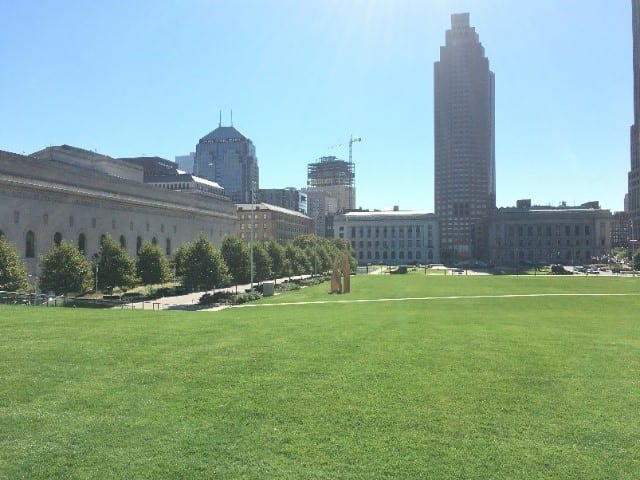
When we were informed that our cohort was headed to Cleveland, I was pleased; I had never been to Cleveland and had spent almost no time in the Rust Belt. I felt it was important to see a city so different from my hometown, New York City. Given all the contemporary discussion about New York’s role in global capitalism, I felt it necessary to examine a city left behind by the very same force.

From the Daniel Burnham, John Carrère, and Arnold Brunner–designed Cleveland Mall to the highways crisscrossing the central core, Cleveland’s built environment seemed to reflect so many of the trends that characterized American urban planning. I saw a quintessentially American city, one where investment so starkly reflected the stages of American capitalism. As we drove through Slavic Village and later through University Circle, or as we walked through the empty streets of downtown Cleveland and the magnificent cavernous banking cathedrals off Euclid Avenue, all I could think about was David Harvey’s theory of accumulation and David Gordon’s “Capitalist Development and the History of American Cities.” As a center of American industry in the 19th and early 20th centuries, Cleveland was showered with investment into the built environment. Cleveland’s “Industrial City” phase was visible in the housing stock in Slavic Village near the factory sites. The skyscrapers surrounding Public Square and throughout the central core reflected Cleveland’s transformation into the “Corporate City.” Applying Harvey’s theoretical model, I saw Cleveland as fundamentally stuck with a built environment for production in an environment that no longer valued industrial production. Cleveland is a city of almost 400,000 built for nearly a million inhabitants. Much of its remaining capital has been siphoned off into the periphery or out of the industrial Midwest entirely. There can’t be an honest discussion about Cleveland’s unless these uncomfortable facts about its past and present are acknowledged.

Cleveland made me sad and angry, because the cityscape manifested everything unfair, vicious, and violent about American capitalism: Empty streets. Plazas hardly filled. No people. I saw a ghost town, ruthlessly abandoned by capital in the race for the bottom. I saw the poor fending for themselves in a subpar, underfunded public transit system. I witnessed white suburbanites coming into town for The Cleveland Orchestra and then fleeing back to the suburbs after the performance. The growth and prosperity we did see in University Circle and Ohio City was so limited in geographical scope and target audience that it was hard to view it as a bright spot. It was merely emblematic of entrenched inequality and the struggle for the city to find meaning post-industrialization. I was not inspired by the panel discussion on foundations, and found the observation about Cleveland becoming the next Austin, Texas due to climate change–induced migration somewhat insensitive and delusional.

That said, I don’t think all is lost. It was apparent throughout the trip that many Clevelanders refuse to give up on their city. Hope remains due to the hard work of community-based organizations, grassroots organizing, and true civic engagement, none of which are in short supply in town. Meaning won’t come just from eds and meds and their multiplier effect; new meaning for a new Cleveland will come about if the necessary coalitions form to address and tackle issues of inequality and wealth redistribution. This is where I see the planning profession as essential: as facilitators and builders of community. Folks like Mordechai from Saturday’s panel, and others who do their work outside of the formal nonprofit framework, can provide great insight into what makes their community prosper. I hope to return to Cleveland one day to visit and to see this in action.
Joel Hochman, MRP 2020